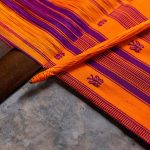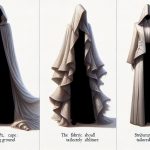Walking through a bustling city, I couldn't help but notice how a cape draped over someone's shoulders transformed their entire presence, exuding an air of mystery and elegance. The way a cape flows behind a person as they move, almost like a superhero traversing through the urban landscape, sparks curiosity about the purpose behind this iconic garment.
From its historical origins to its modern interpretations, the cape holds a significance that goes beyond mere fashion; it symbolizes power, style, and a touch of theatrical flair that draws us in, urging us to uncover its secrets.
Table of Contents
Key Takeaways
- Capes serve as a symbol of power, authority, and status, reflecting historical and cultural significance.
- Capes provide practical weather protection, warmth, and versatility for various occasions and activities.
- Capes make a bold fashion statement, symbolizing elegance and sophistication in modern fashion trends.
- Capes offer a blend of functionality and style, allowing for individual expression and creating memorable fashion moments.
Historical Significance of Capes
Why have capes held such historical significance throughout different cultures and time periods?
Capes have played a vital role in history, dating back to medieval times when they were essential for protection against the elements. In addition to their practical use, capes were also a symbol of social status. In medieval Europe, noblemen often wore capes as a fashion statement, showcasing their wealth and position in society. Similarly, in the Aztec Empire, elite warriors donned capes known as tilmàtlis to display their elevated status.
As society evolved, capes shifted from basic apparel to representing power and occupation. Catholic clergy, for example, wear the ferraiolo cape during formal events to signify their role within the church. The historical significance of capes spans across various cultures and time periods, highlighting their importance in different societal contexts.
From medieval times to the present day, capes have remained a symbol of status, power, and fashion, making them a fascinating aspect of history to explore.
Functional Uses of Capes
I'll start by highlighting the practical benefits of capes, focusing on their ability to shield from weather elements and make a fashion statement.
Capes have historically been used for protection against rain, wind, and cold, offering both warmth and comfort in harsh conditions.
Additionally, they've served as a stylish accessory that allows freedom of movement and flexibility while still providing coverage to the upper body and shoulders.
Weather Protection
Capes serve as essential outerwear for weather protection, shielding the shoulders and upper body from elements like rain, wind, and cold while offering both warmth and mobility.
- Capes are designed to offer coverage for the shoulders and upper body, protecting against inclement weather conditions.
- They serve a practical purpose by providing warmth without restricting arm movement.
- Capes are convenient for changing weather due to their easy removal and wearing.
- These versatile garments are suitable for various weather conditions, combining protection and style effortlessly.
Capes aren't only stylish but also functional, making them a valuable addition to any wardrobe for those seeking both practicality and protection from the elements.
Fashion Statement
Moving from the practical benefits of weather protection, capes also excel in making a bold fashion statement with their versatile design and elegant appeal. Capes serve as a symbol of fashion, adding style and sophistication to any outfit. They are versatile accessories suitable for both casual and formal occasions, instantly elevating an outfit to a more glamorous and eye-catching level. Available in various styles and materials, capes cater to different weather conditions, making them a trendy choice for staying warm in spring, autumn, and winter while maintaining a chic appearance.
| Fashion Statement | |
|---|---|
| Style | Versatile |
| Sophistication | Elegant |
| Glamorous | Eye-catching |
Symbolism in Cape Fashion
When it comes to cape fashion, the symbolism behind these garments runs deep. They've been used throughout history to denote power, status, and cultural significance.
Understanding the historical context, cultural representations, and modern trends of capes can offer intriguing insights into their symbolism in fashion.
Historical Cape Significance
During pivotal historical eras, the cape's significance in fashion transcended mere garments, embodying intricate symbols of power and status.
- Capes denoted social hierarchy, with materials like velvet and fur reserved for royalty and nobility.
- The cape evolved from a practical piece worn by knights for protection in battles to a luxurious fashion statement.
- Different cultures embraced capes as symbols of authority and prestige, reflecting unique design elements and meanings.
- Today, cape fashion continues to showcase elegance, sophistication, and individuality in diverse societal contexts.
Cultural Cape Representations
Capes, as cultural artifacts, embody a rich tapestry of symbolic meanings that transcend mere fabric and design, encapsulating notions of power, prestige, and tradition. In various cultures and historical contexts, capes symbolize authority, leadership, and royalty, reflecting societal values and aspirations.
The association of capes with protection, strength, and dignity is evident in both traditional and modern fashion. Different colors, lengths, and designs of capes carry specific symbolic meanings, adding depth to their representation. The symbolism of capes in fashion serves as a visual language that communicates cultural values and traditions.
Understanding the cultural significance of capes enhances appreciation for their role in expressing power and prestige within society's fashion landscape.
Modern Cape Trends
In modern fashion, the symbolism of capes transcends mere clothing accessories, embodying elegance, sophistication, and individuality. Capes have evolved into a versatile accessory that allows for creative styling, reflecting one's unique taste and personality. Designers are innovating with different fabrics, cuts, and embellishments, turning capes into statement pieces that merge tradition with contemporary flair. The resurgence of capes in fashion speaks to their timeless appeal and adaptability to ever-changing industry trends.
- Capes are no longer just a fashion accessory but a symbol of elegance and sophistication.
- Modern capes offer versatility in styling, allowing individuals to showcase their personal fashion preferences.
- Designers are incorporating unique elements to make capes stand out as statement pieces in wardrobes.
- Capes serve as a creative outlet for expressing individuality and blending traditional and modern fashion sensibilities.
Capes in Pop Culture
Iconic superheroes like Batman and Superman have made capes a staple in pop culture, symbolizing power, mystery, and elegance. Superheroes in comics and movies often don capes to signify their heroic personas, creating a visual representation of strength and heroism. Characters such as Wonder Woman and Thor are also recognized for their distinctive capes in various films and TV shows, further solidifying the cape's status as a symbol of power and courage.
The use of capes in pop culture goes beyond mere fashion; it serves as a visual cue for the audience, instantly conveying the idea of a larger-than-life character. When a superhero's cape billows in the wind as they soar through the sky or stand heroically in a dramatic pose, it captures the essence of their character and adds an element of grandeur to their presence. The cape has become an integral part of superhero lore, representing not just style, but also the enduring themes of justice, bravery, and the eternal struggle between good and evil.
Cape as a Statement Piece
When selecting an outfit, a cape serves as a striking statement piece that effortlessly exudes sophistication and style. Here are four key reasons why capes are essential in the world of fashion:
- Elevated Look: Capes have the unique ability to instantly elevate any outfit, transforming a simple ensemble into a high-fashion statement. Whether draped over shoulders or flowing behind, a cape adds an element of drama and elegance.
- Bold Fashion Statement: Capes make a bold statement in the world of fashion. Their eye-catching presence demands attention and sets the wearer apart from the crowd, showcasing a fearless sense of style.
- Versatile Styles: With various styles available, from classic silhouettes to modern designs, capes offer a wide range of options for personal expression. Whether opting for a traditional cape or a contemporary twist, there's a style to suit every taste.
- Focal Point of an Outfit: A cape can serve as the focal point of an outfit, drawing eyes and admiration. By choosing the right cape, one can create a memorable and unique fashion moment, showcasing individuality and flair.
Practicality of Cape Design
Moving from the enchanting allure of capes as a fashion statement, the practicality of cape design lies in its functionality for everyday activities and styling versatility. Capes are made to provide arm coverage while allowing freedom of movement, making them practical for various tasks like driving or simply going about daily activities.
The design of capes often includes a fastening at the neck, ensuring easy wear and removal for the wearer. Different types of capes are crafted to protect the wearer from the elements, offering both style and functionality. These versatile accessories can be paired with a range of clothing items, adding an elegant touch to any ensemble.
Whether for warmth, style, or a combination of both, capes serve a practical purpose in modern fashion, blending utility with sophistication seamlessly.
Frequently Asked Questions
What Are the Point of Capes?
The point of capes is to add glamour and elegance to outfits while providing practical functionality for various weather conditions. They are versatile, stylish outerwear that can elevate any look, offering both warmth and protection.
What Does a Cape Signify?
Wearing a cape signifies elegance, power, tradition, and mystery. It adds sophistication to fashion, symbolizes authority historically, and embodies superhero iconic imagery. Capes carry cultural significance, making a statement with their dramatic flair and sense of heritage.
Why Did Soldiers Wear Capes?
Soldiers wore capes for protection from the elements, camouflage in battles, easy movement, and carrying supplies. Capes were part of the uniform for identification and rank display. They served practical and tactical purposes in combat scenarios.
What Were Capes Invented For?
Capes were created for practical protection from weather elements, initially for knights and warriors. They evolved as functional outerwear, providing insulation and shielding from rain and wind. Over time, capes shifted into a stylish fashion accessory.
- The Global Economic Role of Fabrics - July 18, 2024
- Future Predictions for the Fabric Market - July 18, 2024
- The Influence of Trade Policies on Textiles - July 18, 2024







